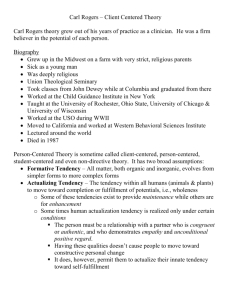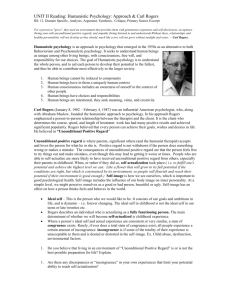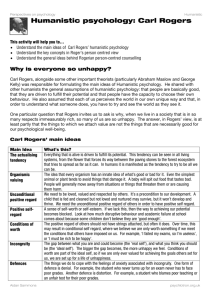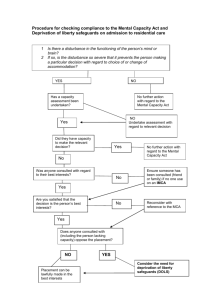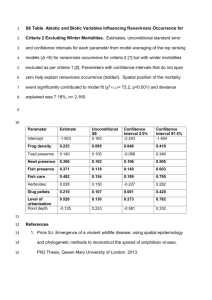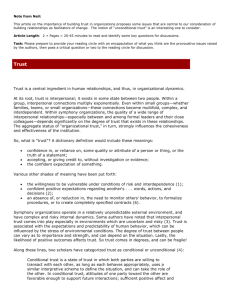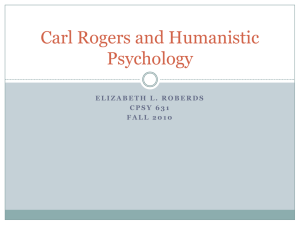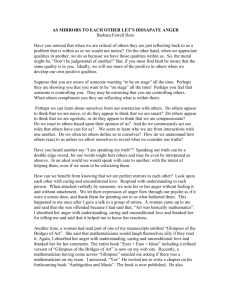Unconditional positive regard reconsidered
advertisement
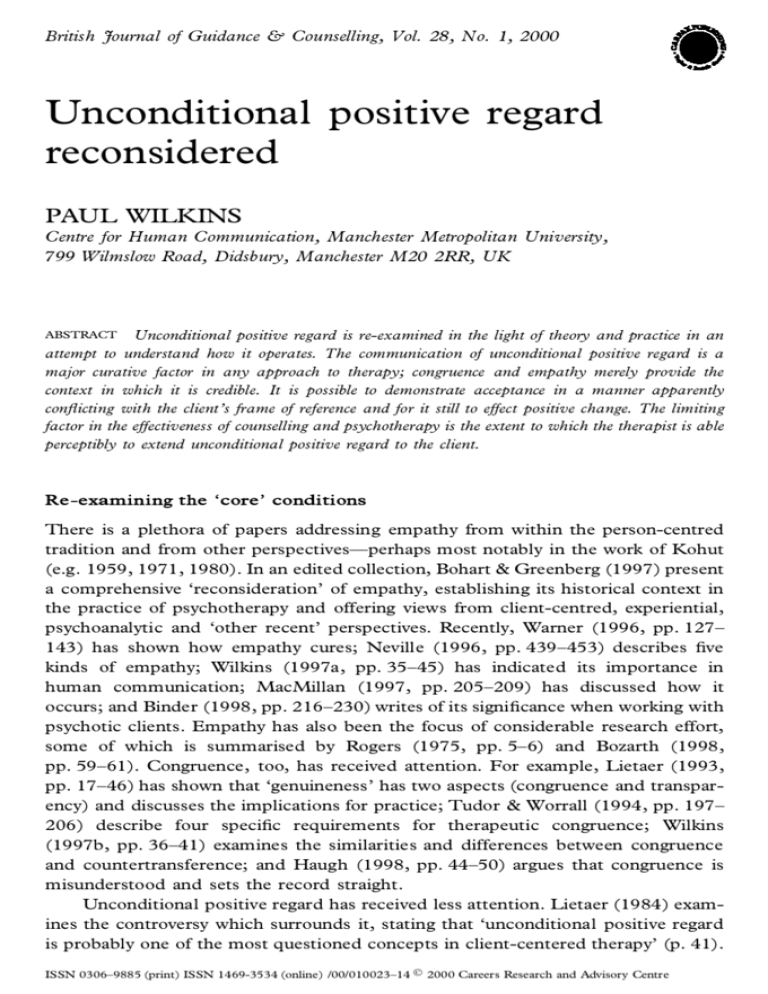
British Journal of Guidance & Counselling, Vol. 28, No. 1, 2000 Unconditional positive regard reconsidered PAUL WILKINS Centre for Human Communication, Manchester Metropolitan University, 799 Wilmslow Road, Didsbury, Manchester M20 2RR, UK Unconditional positive regard is re-examined in the light of theory and practice in an attempt to understand how it operates. The communication of unconditional positive regard is a major curative factor in any approach to therapy; congruence and empathy merely provide the context in which it is credible. It is possible to demonstrate acceptance in a manner apparently con¯ icting with the client’s frame of reference and for it still to effect positive change. The limiting factor in the effectiveness of counselling and psychotherapy is the extent to which the therapist is able perceptibly to extend unconditional positive regard to the client. ABSTRACT Re-examining the `core’ conditions There is a plethora of papers addressing empathy from within the person-centred tradition and from other perspectivesÐ perhaps most notably in the work of Kohut (e.g. 1959, 1971, 1980). In an edited collection, Bohart & Greenberg (1997) present a comprehensive `reconsideration’ of empathy, establishing its historical context in the practice of psychotherapy and offering views from client-centred, experiential, psychoanalytic and `other recent’ perspectives. Recently, Warner (1996, pp. 127± 143) has shown how empathy cures; Neville (1996, pp. 439± 453) describes ® ve kinds of empathy; Wilkins (1997a, pp. 35± 45) has indicated its importance in human communication; MacMillan (1997, pp. 205± 209) has discussed how it occurs; and Binder (1998, pp. 216± 230) writes of its signi® cance when working with psychotic clients. Empathy has also been the focus of considerable research effort, some of which is summarised by Rogers (1975, pp. 5± 6) and Bozarth (1998, pp. 59± 61). Congruence, too, has received attention. For example, Lietaer (1993, pp. 17± 46) has shown that `genuineness’ has two aspects (congruence and transparency) and discusses the implications for practice; Tudor & Worrall (1994, pp. 197± 206) describe four speci® c requirements for therapeutic congruence; Wilkins (1997b, pp. 36± 41) examines the similarities and differences between congruence and countertransference; and Haugh (1998, pp. 44± 50) argues that congruence is misunderstood and sets the record straight. Unconditional positive regard has received less attention. Lietaer (1984) examines the controversy which surrounds it, stating that `unconditional positive regard is probably one of the most questioned concepts in client-centered therapy’ (p. 41). ISSN 0306± 9885 (print) ISSN 1469-3534 (online) /00/010023± 14 Ó 2000 Careers Research and Advisory Centre 24 Paul Wilkins Kilborn (1996, pp. 14± 23) presents the ® ndings from an empirical study of her practice; Purton (1998, pp. 22± 37) considers unconditional positive regard and its spiritual implications; and Bozarth (1998, pp. 86± 88) offers an overview. It puzzles me that what Bozarth (p. 83) describes as `the curative factor in client-centred theory’ has received more limited attention than the other two core conditions. For whatever reason, unconditional positive regard, which `seems effective in bringing about change’ (Rogers, 1959, p. 208) and the communication of which (with empathic understanding) is the sixth of Rogers’ `conditions of the therapeutic process’ (p. 213), has been less examined and is arguably less well understood. What is unconditional positive regard? In 1957, Rogers (reproduced in Kirschenbaum & Henderson, 1990) de® ned unconditional positive regard thus: `It involves as much feeling of acceptance for the client’s expression of negative, ª badº , painful, fearful, defensive, abnormal feelings as for his expression of ª goodº , positive, mature, con® dent, social feelings, as much acceptance of ways in which he is inconsistent as of ways in which he is consistent. It means caring for the client, but not in a possessive way or in such a way as simply to satisfy the therapist’s own needs. It means a caring for the client as a separate person, with permission to have his own feelings, his own experiences’ (p. 225). Rogers associated the terms `prizing’ , `warmth’ and `acceptance’ with this quality. Mearns & Thorne (1988) offer a de® nition `in fairly straightforward language’: `Unconditional positive regard is the label given to the fundamental attitude of the person-centred counsellor towards her client. The counsellor who holds this attitude deeply values the humanity of her client and is not de¯ ected in that valuing by any particular client behaviours. The attitude manifests itself in the counsellor’s consistent acceptance of and enduring warmth towards her client’ (p. 59). These de® nitions help to get towards an understanding of unconditional positive regard. The ® rst tells what it looks like, what must be done in order to offer it (it is an operational de® nition), while the latter tells that it is an attitude which must be held towards another. But I have a sense that my understanding of this condition is incomplete, perhaps because I have used the term `acceptance’ as if it were an exact synonym for unconditional positive regard and, although Rogers (1967, p. 283) indicates that he too does this, I wonder if to do so means to miss some essential element. The sense of this condition is that it has the qualities of being absolute, actual beyond the possibility of doubt, and that it relates to esteem and respect for another. To experience the unconditional positive regard of another, I must be convinced of their deep, unquali® ed esteem and respect for my total being. This is helpful, but it still leaves me with questions. Just what is being asked of me, and how do I do it? Unconditional positive regard reconsidered 25 Also, is unconditional positive regard similar to (or the same as) agape? Setting the counselling relationship in an historical context, Feltham (1999) ponders `the in¯ uence of centuries of religion and religious practice in daily life and ritual’ (pp. 6± 7) and states: `secular humanism leaves many without a God to turn to; fragmented and mobile, competitive societies leave many without stable supportive communities and community ® gures, such as priests, who previously supplied many valued facilities including the confessional; and the breakdown of the concept of sel¯ ess duty, altruism or love (Agape) also leaves a large hole in the social and interpersonal fabric’ (p. 7). Is the unconditional positive regard of a therapist necessary to replace the sel¯ ess love which may previously have been offered elsewhere? Arguably, there is a recognition of the value of something like unconditional positive regard to well-being and growth in the tenets of major religions. For example, Purton (1996, p. 459) equates the Buddhist concept of counteracting lobha or greed with the development of unconditional positive regard and `forgiveness’ and compassion are at the heart of Christian (and other) belief. If these are to be offered to their fullest extent, perhaps there is a requirement for acceptance of the other on the part of the bestower. Patterson (1974, pp. 89± 90) indicates that love or agape is what is offered by a therapist extending the facilitative conditions, and that this re¯ ects the wisdom of thousands of years of human experience and the conclusions of `great philosophers of various times and cultures’ (p. 90). However, unconditional positive regard is only one of these facilitative conditions. When I and my students ® rst heard Brian Thorne describe the quality to which he refers as `tenderness’ (Thorne, 1991, pp. 73± 81) which is a sublime culmination of the facilitative conditions in combination, we thought that love (by which we meant agape) would have served equally well as a label. It seems, therefore, that unconditional positive regard is not the same as agape, but is an aspect of itÐ if undoubtedly an essential aspect and perhaps the most important. In an attempt to understand unconditional positive regard more completely, I considered what it might mean to reverse each of its elements. Conditional positive regard is the offering of warmth, respect, acceptance, etc. only when the other ful® ls some particular expectation, desire or requirement; it is offered when one person conveys to another, `I will only approve of, like, favour you if you do this, give me this, act in this way’ . When (for example) a parent does this to a child, in terms of person-centred theory there may be a resulting distortion in the development of conditions of worth (Rogers, 1959, pp. 224± 225). Conditional positive regard can also be a facet of therapy when the therapist has an agenda different from that of the client and acts to `reward’ appropriate behaviour; or, as Mearns (1994) warns, when the therapist aligns `more strongly with one part of the personality against (an)other’ and so colludes `with part of the client to reject another important part of himself’ (p. 15). At the very best, supporting `positive’ aspects of the client at the expense of `negative’ aspects, or encouraging and actively approving some patterns of thought or behaviour in preference to others, isÐ because some element of the client’s total 26 Paul Wilkins being is neglected or ignoredÐ likely to be a block to therapeutic change and may be damaging. Unconditional negative regardÐ that is, when one person conveys to another, `Whatever you say or do, however you are, I will hate, despise, demean or denigrate you’ Ð also has extreme consequences. In its most active and virulent form, it is the root of racism, homophobia, sexism and the like. Unconditional negative regard is also damaging in a more passive formÐ that is, as the complete neglect by one person of one or more aspects of another. These remain unseen and unresponded to even when warmth and acceptance are extended to other parts. This differs from conditional positive regard (although its effects may be similar) in that the person showing it towards another is unconscious of what they are ignoring, and may even experience themselves as totally warm, accepting and caring towards the other. Unconditional positive disregard occurs when one person refuses to enter into a relationship of any kind with another. It is paying no attention to and being neglectful of another whatever they say or do, or however they act. In an extreme form, it is the complete negation of the existence of one person by another. This can be so powerful that receivers of it come to doubt their right to life. An example of unconditional positive disregard is the psychoanalytic concept of the `dead mother’ (Schutzenberger, 1991), where a child born after the death of a sibling is not seen by the mother, who instead sees only her dead child when she looks at her new baby. Schutzenberger states `very often, the child of this ª dead motherº will have a dif® cult life, suicidal tendencies or suffer from schizophrenia or other kinds of problems’ (p. 218). A distressed, bored or unengaged therapist is in danger of offering unconditional positive disregard. In terms of person-centred theory, the consequence of each of these three is the development of conditions of worth because (when experienced by babies from, for example, their mothers) each amounts to the withholding of unquali® ed love. However it happens, the absence of unconditional positive regard is harmful: as Bozarth (1998) points out, `conditionality is the bedrock of Rogers’ theory of pathology’ (p. 83). Although each of these ways of behaving towards another may have the same result, operationally they differ. Understanding this difference leads to a fuller understanding of the bene® ts of unconditional positive regard. Unconditional positive regard in operation The acceptance of the client by the therapist is an essential element of counselling and psychotherapy. How its effectiveness is understood in theoretical terms may differ. For example, Jacobs (1988, p. 13) records that a psychodynamic counsellor would expect `unconditional regard’ to encourage positive transference. From a person-centred perspective, the unconditional positive regard of the counsellor promotes the self-acceptance of the client, and this allows change. Rogers (1951) writes: `we cannot change, we cannot move away from what we are, until we thoroughly accept what we are’ (p. 17). Acknowledging that it is sometimes very dif® cult to accept another unconditionally, Rogers (in Hobbs, 1987) states: `If I really care about (another) person in Unconditional positive regard reconsidered 27 an unconditional way, that’s helpful’ (p. 20). Barrett-Lennard (1998) outlines person-centred self-theory and states, commenting: `an effect of conditions of worth is that the individual is no longer freely open to experience ¼ the resulting incongruence between self and experience, involves a state of ª vulnerabilityº and a degree of dysfunction. However, its effect is also to minimise inner con¯ ict and anxiety’ (pp. 77± 78). This process results in the development of a psychological defence which `allows the individual to maintain an acceptable self-concept, while the implicit conditions of worth remain out of view and unaffected’ (ibid.). Rogers (1959) states that `for the process of defense to be reversed’, there must be a decrease in the conditions of worth and an increase in unconditional self-regard. He adds that experiencing unconditional positive regard from `a signi® cant other’ is one way of achieving this, and that for unconditional positive regard to be communicated `it must exist in the context of empathic understanding’. When this happens, conditions of worth `are weakened or dissolved’ (p. 230). The conclusion drawn from theory is that communicating unconditional positive regard will effect change. However, for a therapist to hold that as an expectation and certainly as a desire (however well-intentioned) may be counterproductive and may actually limit the effectiveness of therapy. Implicit in the holding of another in unconditional positive regard is an acceptance of their right as a selfdetermining individual not to change, to be `cured’ or to grow. It is natural for a therapist (of whatever complexion) to want the client to change and perhaps even to form a vision of what change might lead to; but, for some clients at least, only when this desire is let go does change become possible. Mearns (1999) has pointed out that one aspect or `con® guration’ of many clients is `not for growth’ , and gives examples including `the ª meº that just wants to curl up and do absolutely nothing’ and `the part that wants to go back’ . He stresses the importance of including these `not for growth’ con® gurations of self in therapy stating: `It is not any one con® guration within the client’ s Self which is important but the whole constellation of con® gurations and the dynamics which de® ne their inter-relationship. It is this dynamic integration which will result in an overall picture that re¯ ects the person’s Self. If we miss out parts or ban them from therapy because they are too dif® cult for the therapist, we are offering a conditional relationship and one which is likely to be anti-therapeutic’ (p. 127). Offering unconditional positive regard is not always easy, but it is worth the effort. For example: A `dif® cult’ client presented at my place of work. He had previously been seen by one of my colleagues, of whom he had little good to say. In his expressed view, the service for which we worked was useless and counselling was worse. And yet he wanted an appointment. With some forebod- 28 Paul Wilkins ing, I agreed to meet with him for counselling. I had a sense of being tested to my limits. This was con® rmed when he arrived for his ® rst appointment driving an army surplus armoured car and began telling me of his love of the military and hatred of women and black people in particular. All this challenged my liberal attitudes, and yet I knew that the ef® cacy of our relationship depended upon me being accepting, not merely acting the part. As I listened and responded to him, I began to wonder about what life experiences had led him to his extreme views. The tale he told was of mistreatment as a child and a tempestuous relationship with his wife, who he experienced as `robbing’ him of his house and his business. Between sessions, I read about prejudice and how it might arise. Almost without noticing, I slipped from being challenged by my client’s way of being to an appreciation of the person of worth behind the views. As this happened, there was a softening in him, sessions began to include humour and a sense of companionship in the counselling enterprise. It was as if, as he accepted himself more, he became more accepting of the world. We only met for six sessions and I’m sure that he remained a misogynist and a racist (and I ® nd that I want to say that did not matter to me), but there was an easing of his attitudes. I think we were both changed by the process. Part of my change lay in the realisation that `acceptance’, unconditional positive regard, was exactly thatÐ the issue of my approval or disapproval, my judgement of the views and way of being of another, was impertinent and immaterial. Experiencing an attitude of unconditional positive regard with respect to this client involved a deep acceptance of how he wasÐ he had racist and misogynist views, but these were essential to his way of being in the world. He was doing the best he could, given his antecedents and the way he perceived the world to be. What was required of me was an acceptance of how things were, and this was in some way independent of `approval’ and `disapproval’. Unconditional positive regard is the curative factor in therapy. When it is experienced by one person from another, it is growth-promoting regardless of the setting. I am aware of having experienced `growth’ as I have perceived the increasingly unconditional positive regard of clients. The more I perceive myself as being seen and accepted for what I am, the more likely I (as therapist) am to change positively in the therapeutic encounter. I have also noticed that, as my clients approach the end of therapy, they are more likely to offer me unconditional positive regard. For example: I had been working with Jane for nearly two years. We had been through a great deal together and her perceptions of me had changed a lot. To begin with, I had been the `expert’, owner of some arcane knowledge which would help her through her confusion. As this confusion had Unconditional positive regard reconsidered 29 cleared, I had become a guide, perhaps even paternal, older, presumed to be wiser, certainly someone in whom she could con® de. As we neared our 24th month, I was aware of how easy it now was to be with Jane. After the trauma and distress we had been through together, we were at last peaceful in each other’s presence. I felt she saw me as I was and that she was happy for me to be however I was. It was then that she told me she didn’t need to come any moreÐ I had no doubt that she was right. We ended well, with some sadness at our parting, but no regret. Six months later I had a postcard from the South Seas to tell me of the adventure she had embarked on as a consequence of our time together. Jane’s journey could be understood as one from incongruence and anxiety, through self-acceptance and `mutuality’ (see Mearns & Thorne, 1988, pp. 126± 129) to an ability to accept others. An alternative but related view would be that of Brazier (1993, pp. 72± 90): that Jane rediscovered her ability to give unconditional positive regard rather than to receive it, and that it was this that was transformative. Bozarth (1998) quali® es the view that unconditional positive regard is `the curative factor of (person-centred) theory’ stating: `It is (the actualising) tendency that is the fundamental curative factor lying within the person. The reference to unconditional positive regard as the curative factor assumes the thwarting of the natural tendency; hence, making it necessary that the client become more directly connected with the actualising tendency through unconditional positive self regard’ (p. 82). This does not con¯ ict with Rogers’ (1957, p. 96) integrative statement which asserts that any therapist who demonstrates an accepting understanding of the client while being fully present in the relationship will facilitate change. To restate this: any person regardless of the setting or their belief in the nature of humans is likely to promote positive change in another if they communicate their undoubtable unconditional positive regard for this second person. Mearns (1994, pp. 3± 5) points out that accepting somebody is very different from liking them: `liking’ is based in shared values or complementary needsÐ in other words, `liking’ is conditional. He also points out that person-centred counsellors seek to be `beside’ their clients, not `on their side’ ( p. 54): that is, to be as close to the client’ s experiencing as possible, not allying with their thoughts and feelings. The ® rst is an accepting position; the second is, or may become, conditional. Lietaer (1984) considers that unconditionality has its problems: `(1) There is a potential con¯ ict between genuineness or congruence on the one hand, and unconditionality on the other; (2) It is a rare person and a rare time in which the constancy of acceptance can be provided by any therapist for any client. Thus, while unconditionality is not impossible, it is improbable; (3) Unconditionality calls upon the therapist for a devoted self-effacing that often leads to a compensatory reaction in which confrontation becomes a form of self-assertion’ (p. 41). 30 Paul Wilkins Lietaer sees that these questions and dif® culties arise as client-centred therapy becomes more relationship-centred, with a resulting increased prominence given to the therapist’s congruence (`which implies among other things feedback and confrontation’). Bozarth (1998) believes Lietaer to be in error, expressing the view that `client-centred’ and `relationship-centred’ are not differently de® ned and that Lietaer’s `behavioral de® nition of genuineness as involving feedback and confrontation’ leads to a shift in emphasis from trusting the client’s experience towards trusting the `expertise’ of the therapist (p. 85). I am inclined to accept Bozarth’s view. In the 18th proposition of his personality theory, Rogers (1951) explains the link between self-acceptance and the acceptance of others: `When the individual perceives and accepts into one consistent and integrated system all his sensory and visceral experiences, then he is necessarily more understanding of others and is more accepting of others as separate individuals ’ (p. 520). Lietaer (1984) links congruence and `acceptance’, seeing them as `parts of a more basic attitude of ª opennessº ’. Congruence is openness towards one’s self, while unconditional positive regard is openness towards another. He states: `The more I accept myself and am able to be present in a comfortable way with everything that bubbles up in me, without fear or defense, the more I can be receptive to everything that lives in my client. Without this openness, without this acceptance, it is not possible to let the experience of my client unfold, to let it come to life fully; for with a conditional attitude the chances are great that I dare not see certain parts of the client’s experience, and that I will minimise or reject some of them’ (p. 44). Because it depends on the attitude individuals hold towards themselves, unconditional positive regard is the hardest therapeutic attitude to develop. It cannot be effectively faked, and tolerance (the ability to patiently endure or `allow’) is quite different. I have doubts, too, about the much-repeated notion of accepting the person but not the behaviour. While it is neither ethical nor appropriate for a therapist to condone antisocial or harmful behaviour or to collude in its perpetuation, there is a real risk that in attempting to hold the attitude `I disapprove of what you do but I accept you’, the therapist will fail to offer unconditional positive regard, and the client experience is then one of censure and perhaps rejection. What is required is an ability to see and connect with the person behind the `repulsive’ or `repugnant’ behaviour or attitude (perhaps as in the case history above). In some way this reduces the need to tolerate or judge the reprehensible thought, act or deed. This necessary paradox is essential to effective therapy. The attitude of unconditional positive regard requires that, while the therapist does not collude with harmful or antisocial behaviour, it is neither condoned nor opposed. This may not mean that `confrontation’ is impossible in person-centred therapy. Lietaer (1984) discusses `confrontation and unconditionality’, and points out that `confrontation does not in any way mean that I reject my client as a person or Unconditional positive regard reconsidered 31 that I stop trying to understand his experience’ (pp. 54± 57). If the unconditional positive regard of the therapist is experienced by the client, then challenge and confrontation may play a useful part in therapy. Certainly, being person-centred is not about being passive or `nice’, but a necessary component of unconditional positive regard is an acceptance of the client’s authority and self-expertise. It is not for the therapist to decide on or direct the course of change, or even to assume it must happen. If the proposition is accepted that `psychopathological’ and/or antisocial ways of being are induced by conditions of worth, and that communicating unconditional positive regard is a way of redressing these, then it is implicit that effective therapy is limited only by the therapist’s ability to experience and convey this attitude to the client. If the ® rst of Rogers’ (1957, p. 96) six conditionsÐ that is, the requirement for psychological contactÐ can be met [and Prouty (1976, pp. 290± 295) shows that even this requirement is not absolute], then there are no clients who are by de® nition unsuitable for psychotherapy. Although the terms used may be different, this is not necessarily a problem from other theoretical perspectives. Any apparent difference seems to reside in the issue of `contact’. For example, Jacobs (1988, p. 53) lists distinguishing features which suggest that a potential client is unsuitable for psychodynamic therapy. These can be understood as restricting psychological contact. The experience of person-centred therapists challenges some of these `disquali® cations’. There are published accounts of the usefulness of person-centred therapy when working with people described as schizophrenic (e.g. Teusch, 1990, pp. 637± 644; Berghofer, 1996, pp. 481± 494) and people seen as having a learning dif® culty (e.g. PoÈrtner, 1990, pp. 659± 670), and Lambers (in Mearns, 1994, pp. 110± 120) has written of person-centred therapy with people with a variety of `psychopathologies’ . Although empathy and congruence are seen as playing an important part in working with these clients, it is the ability of the therapist to accept unconditionally the (sometimes bizarre) nature of the client’ s inner world and its subjective reality, as well as some notional `healthy’ core or rational facet, that increases the likelihood of psychological contact and therefore therapeutic change. For example: One of my students came to me one day to tell me that her supervisor thought she should stop seeing one of her clients because he was `psychotic’. My student felt very strongly that she had a relationship with this client and that the point of counselling was not to `cure’ the psychosis (which in any case seemed of marginal relevance to her) but to stay alongside her client as he travelled what was a traumatic and dif® cult path. She did not know that psychotic people were not susceptible to counselling interventions and that they were thought by some people to be incapable of forming a therapeutic relationship. So, with the agreement that she ensure her personal safety in a variety of ways, she continued to see this client and carried on responding to him in a person-centred way. While ® rmly rooted in her reality, she entered into his delusional world to some extent `as if’ it were her own, and noticed that 32 Paul Wilkins as she did so his periods of rationality began to increase. He would still behave bizarrely in her presence but, every so often, his voice and demeanour would return to normal and he would thank her for staying with him through what he knew was a dif® cult episode for them both. This continued for some weeks until the client was once again able to encounter the world with con® dence and to connect with people. He said to my student that it was the ® rst time anybody had attempted to stay with him throughout a ¯ orid episode. He reported that even at his most delusional he had been aware of her presence and that her steadfast and accepting nature and her obviously genuine desire to understand what it was like to be him had been very comforting, reassuring and helpful. His psychotic episode had been relatively short in comparison to his previous experience. In our conversations during and after this therapeutic relationship, I was aware of my student’s insistence that her client was worthy of deep respect and of his right to his fantasy world and odd behaviourÐ that is, his right to be himself as he was at any time. The reason that psychotherapeutic interventions are seen not to `work’ with, for example, people in a psychotic state, and paedophiles, may have much more to do with the belief, fear, disapproval and revulsion of the therapists than with the supposed intractable nature of the clients. However open-minded therapists believe themselves to be, however tolerant they are, if the client does not experience unconditional positive regard, then the likelihood is that therapy will fail. There is limited support for this view from research (perhaps because research into the effectiveness of person-centred therapy centres on all the conditions or on the relationship per se), but examples include Eckert & Wuchner (1996), which is a study of work with people diagnosed as having a borderline disorder. They emphasise the need for client-centred psychotherapists to `hang on tightly’ to their unconditional positive regard when working with this client group: `As a result of what they have already been through these patients are profoundly frightened of being manipulated and misused. One form of misuse they are particularly wary about is that the therapist hopes their symptoms will vanish soon, con® rming that he is a ª goodº therapist. So the client-centred therapist is well-advised to aim genuinely at nothing other than really understanding his borderline client. Faced by this kind of fear once I remarked to the patient: ª I am not interested in making you better but in helping you to understand yourself betterº , and the patient was quite obviously very relieved’ (pp. 213± 233). That the ability to offer effective therapy is limited by the therapist’s qualities, and not those of the client, lays a great responsibility on the therapist, for we will each only become more effective by addressing our own issues. Our ability to offer unconditional positive regard to others depends on our capacity for unconditional Unconditional positive regard reconsidered 33 self-regard. Rogers (in Kirschenbaum & Henderson, 1990) wrote about the challenge of self-acceptance and its value to the counsellor: `If I can form a helping relationship to myselfÐ if I can be sensitively aware of and acceptant toward my own feelingsÐ then the likelihood is great that I can form a helping relationship with another’ (p. 120). The relative importance of unconditional positive regard In a way, it is nonsense to attempt to rank Rogers’ six conditions. He states (1957) that all six, if they exist over a period of time, are necessary and suf® cient to ensure `constructive personality change’ (p. 96). Bozarth (1998) argues persuasively that empathy, unconditional positive regard and congruence `are really, ultimately and functionally one condition’ (p. 80). However, Lietaer (1993, p. 17) asserts that from 1962 Rogers called congruence the most fundamental of the core conditions. Thorne (1991) writes: `Acceptance, empathy and congruenceÐ these three, as always, but the greatest and the most dif® cult and the most exciting and the most challenging is congruence’ (p. 189). Person-centred therapists often believe that congruence takes precedence over the other core conditions. However, in both terms of theory and my personal experience, I ® nd it hard to accept that congruence is the most important condition. It is challenging, it is exciting, but if any condition is more important than the others it is surely the sixthÐ that empathic understanding and unconditional positive regard are communicated. Also, though perhaps only in unusual circumstances, constructive personality change can occur when unconditional positive regard is communicated in the apparent absence of empathic responses. I agree with Bozarth (1998) that `the interrelationship of the conditions of congruence, empathy and unconditional positive regard is so high that they are inseparable in the theory’ (p. 83), and I extend this to practice. This is because empathy and congruence provide a framework in which unconditional positive regard is believable, but it is also because it is impossible to be truly accepting of another without being open to one’s own inner experience and being in a personal state of harmony. Also, in operation, there is sometimes little to distinguish deep empathy from unconditional positive regard. For example: Jim held a position of considerable responsibility and authority in a large corporation. The ef® cacy of his work was dependent upon a close collaborative relationship with his colleagues. Jim was experiencing one of his colleagues as not pulling his weight and a formerly cordial relationship between them had broken down. Jim was currently feeling very hurt and damaged by his colleague’s behaviour. As he described all this to me, without really thinking, I said, `You wish he would fuck off and die.’ There was instantly a look of profound relief on 34 Paul Wilkins Jim’s face and, at ® rst softly and then with increasing vehemence, he repeated my phrase several times. Somehow the phrase I used seemed to have the right force. Perhaps I had empathically sensed Jim’s desire that his colleague cease to exist but, as I spoke, I sensed that what was important was that I knew Jim felt as he did and that I accepted him. Jim later con® rmed that the way I had acknowledged and accepted an extreme negative feeling he had not previously admitted to himself was crucial to our relationship and to his resolving his workplace issues. In some way he was changed by hearing me acceptingly voice his hidden wish. In therapy and other relationships, there have been times when I have been similarly affected. It has been like the ¯ icking of a switch; whether something has been turned on or off I am unsure, but I do know that the transformation is abrupt and apparently complete and everlasting. I have not necessarily been aware of the empathic understanding of the other person, but I have been sure that they have accepted in me what has hitherto been so unacceptable to me that I have not even recognised its existence. I cannot begin to do justice to the power of this experience as I have felt it for myself and witnessed it happen to others. When this occurs, there is an equivalent in terms of unconditional positive regard of what Mearns & Thorne (1988) de® ne as `depth re¯ ection’ (p. 42)Ð that is, the communication of an empathic sensing of something just below the level of the client’s awareness. This leads to the conclusion that, if any condition is more important than another, it is the communication of unconditional positive regard. This can itself effect constructive change. In this respect, unconditional positive regard is unique. Rogers (1954, p. 33; 1956, pp. 199± 200) may be interpreted as suggesting that congruence is itself transforming (because it provides a context of `reality’), but this is only because the realness of therapists gives credence to their unconditional positive regard and their empathic understanding. Implications for practice If unconditional positive regard is the most crucial therapist attitude (regardless of the nature of therapy), there are profound implications for practice. Even given that to hold someone in unconditional positive regard is `sometimes very dif® cult’ (Rogers quoted in Hobbs, 1987, p. 20) and that for the therapist to accept the client in the moment is desirable, not mandatory, if when therapy breaks down a likely cause is the limited acceptance of the therapist, and if `untreatable’ clients are unacceptable clients, then there is an implicit duty on therapists to maximise their ability to accept others. Because of this, it is not congruence which presents the greatest challenge to therapists, but unconditional positive regard. This requires that therapists approach their clients without prejudice, with respect for who and what they are, and with a recognition that they are self-determining persons. Because we have values and opinions, because few of us are without our own pain and shame, this is very dif® cult. Perhaps the ® rst thing each of us needs to accept is that our ability to offer unconditional positive regard is limited; the second is to discover those limits and to seek to expand them (while working within them in the interim). How to do Unconditional positive regard reconsidered 35 this is a matter of choice and opportunity. Personal therapy is a well-known route, joining a self-development group may be helpful, but it might be that meditation or some other contemplative practice serves as well. On a practical level, it may help to re-evaluate attitudes to practice and to clients. Dogma is the enemy of unconditional positive regard. Certainly it is worth critically appraising existing conventions of practice and developing a credulous attitude to clients and the ways in which we behave towards them. Any notion of the client as attention-seeking or manipulative seems to have little to do with unconditional positive regard. If someone is attention-seeking, does this not bespeak a deep need to be attended to? Similarly, when a client is late for an appointment or misses it altogether, does this merit a punitive response, or should I be attending to and accepting of the implied message or obscurely expressed need? Is it accepting to insist that clients meet with me for one hour a week at a place of my choosing? I am not suggesting that the communication of unconditional positive regard necessitates a permissive attitude towards clients, but I do suggest that sometimes the structures of therapy are relied upon uncritically and that this may lead to less effective practice. The ability to develop and convey an attitude of unconditional positive regard depends on a willingness to approach each person as an individual with unique needs. This is not without tensions. These can only be resolved on a case-by-case basis. References BARRETT -LENNARD , G.T. (1998). Carl Rogers, Helping System: Journey and Substance. London: Sage. BERGHOFER , G. (1996). Dealing with schizophreniaÐ a person-centered approach providing care to long-term patients in a supporting residential service in Vienna. In R. HUTTERER , G. PAWLOWSKY, P.F. SCHMID & R. STIPSITS (Eds), Client-Centered and Experiential Psychotherapy: a Paradigm in Motion. Frankfurt-am-Main: Peter Lang. BINDER , U. (1998). Empathy and empathy development with psychotic clients. In B. THORNE & E. LAMBERS (Eds), Person-Centred Therapy: a European Perspective. London: Sage. BOHART, A.C. & GREENBERG , L.S. (Eds) (1997). Empathy Reconsidered: New Directions in Psychotherapy. Washington, DC: American Psychological Association. BOZARTH, J.D. (1998). Person-Centered Therapy: a Revolutionary Paradigm. Ross-on-Wye: PCCS Books. BRAZIER , D. (1993). The necessary condition is love: going beyond self in the person-centred approach. In D. BRAZIER (Ed.), Beyond Carl Rogers. London: Constable. E CKERT, J. & WUCHNER, M. (1996) Long-term development of borderline personality disorder. In R. HUTTERER , G. PAWLOWSKY, P.F. SCHMID & R. STIPSITS (Eds), Client-Centered and Experiential Psychotherapy: a Paradigm in Motion. Frankfurt-am-Main: Peter Lang. FELTHAM, C. (1999). Contextualising the therapeutic relationship. In C. FELTHAM (Ed.), Understanding the Counselling Relationship. London: Sage. HAUGH, S. (1998). Congruence: a confusion of language. Person-Centred Practice, 6(1), 44± 50. HOBBS, T. (1987). The Rogers interview. Counselling Psychology Review, 4(4), 19± 27. JACOBS, M. (1988). Psychodynamic Counselling in Action. London: Sage. KILBORN , M. (1996). The quality of acceptance. Person-Centred Practice, 4(1), 14± 23. KIRSCHENBAUM , H. & HENDERSON, V.L. (Eds) (1990). The Carl Rogers Reader. London: Constable. KOHUT, H. (1959). Introspection, empathy and psychoanalysis. Journal of the American Psychoanalytic Association, 7, 459± 483. KOHUT, H. (1971). The Analysis of Self. New York: International Universities Press. KOHUT, H. (1980). Re¯ ections. In A. GOLDBERG (Ed.), Advances in Self Psychology. New York: International Universities Press. 36 Paul Wilkins L IETAER , G. (1984). Unconditional positive regard: a controversial basic attitude in client-centered therapy. In R.F. LEVANT & J.M. SHLIEN (Eds), Client-Centered Therapy and the Person-Centered Approach: New Directions in Theory, Research and Practice. New York: Praeger. L IETAER , G. (1993). Authenticity, congruence and transparency. In D. BRAZIER (Ed.), Beyond Carl Rogers. London: Constable. MACMILLAN , M. (1997). The experiencing of empathy: what is involved in achieving the `as if’ condition? Counselling, 8(3), 205± 209. MEARNS , D. (1994). Developing Person-Centred Counselling. London: Sage. MEARNS , D. (1999). Person-centred therapy with con® gurations of self. Counselling, 10(2), 125± 130. MEARNS , D. & THORNE, B. (1988). Person-Centred Counselling in Action. London: Sage. NEVILLE , B. (1996). Five kinds of empathy. In R. HUTTERER , G. PAWLOWSKY, P.F. SCHMID & R. STIPSITS (Eds), Client-Centered and Experiential Psychotherapy: a Paradigm in Motion. Frankfurtam-Main: Peter Lang. PATTERSON , C.H. (1974). Relationship Counseling and Psychotherapy. New York: Harper & Row. POÈRTNER , M. (1990). Client-centered therapy with mentally retarded persons: Catherine and Ruth. In G. LIETAER , J. ROMBAUTS & R. V AN BALEN (Eds), Client-Centered and Experiential Psychotherapy in the Nineties. Leuven: Leuven University Press. PROUTY , G.F. (1976). Pre-therapy, a method of treating pre-expressive psychotic and retarded patients. Psychotherapy: Theory, Research and Practice, 13(3), 290± 295. PURTON, C. (1996). The deep structure of the core conditions: a Buddhist perspective. In R. HUTTERER , G. PAWLOWSKY, P.F. SCHMID & R. STIPSITS (Eds), Client-Centered and Experiential Psychotherapy: a Paradigm in Motion, Frankfurt-am-Main: Peter Lang. PURTON, C. (1998). Unconditional positive regard and its spiritual implications. In B. THORNE & E. LAMBERS (Eds), Person-Centred Therapy: a European Perspective. London: Sage. ROGERS, C.R. (1951). Client-Centered Therapy. Boston: Houghton Mif¯ in. ROGERS, C.R. (1954). The case of Mrs. Oak. In C.R. ROGERS & R.F. DYMOND (Eds), Psychotherapy and Personality Change. Chicago: University of Chicago Press. ROGERS, C.R. (1956). Client-Centered Therapy (3rd edn). Boston: Houghton-Mif¯ in. ROGERS, C.R. (1957). The necessary and suf® cient of therapeutic personality change. Journal of Consulting Psychology, 21, 95± 103. ROGERS, C.R. (1959). Therapy, personality and interpersonal relationships. In S. KOCH (Ed.), Psychology: a Study of a Science, Vol 3: Formulations of the Person and the Social Context. New York: McGraw-Hill. ROGERS, C.R. (1967). On Becoming a Person. London: Constable. ROGERS, C.R. (1975). Empathic: an unappreciated way of being. Counseling Psychologist, 5(2), 2± 10. SCHUTZENBERGER , A.A. (1991). The drama of the seriously ill patient: ® fteen years’ experience of psychodrama and cancer. In P. HOLMES & M. KARP (Eds), Psychodrama: Inspiration and Technique. London: Routledge. TEUSCH, L. (1990). Positive effects and limitations of client-centered therapy with schizophrenic patients. In G. LIETAER , J. ROMBAUTS & R. V AN BALEN (Eds), Client-Centered and Experiential Psychotherapy in the Nineties. Leuven: Leuven University Press. THORNE, B. (1991). Person-Centred Counselling: Therapeutic and Spiritual Dimensions. London: Whurr. TUDOR, K. & WORRALL , M. (1994). Congruence reconsidered. British Journal of Guidance and Counselling, 22(2), 197± 206. WARNER , M.S. (1996). How does empathy cure? A theoretical consideration of empathy, processing and personal narrative. In R. HUTTERER , G. PAWLOWSKY, P.F. SCHMID & R. STIPSITS (Eds), Client-Centered and Experiential Psychotherapy: a Paradigm in Motion, Frankfurt-am-Main: Peter Lang. WILKINS , P. (1997a). Empathy: a desirable quality for effective interpersonal communication? Applied Community Studies, 3(2), 35± 45. WILKINS , P. (1997b). Congruence and countertransference: similarities and differences. Counselling, 8(1), 36± 41. (Accepted 22 October 1999)
